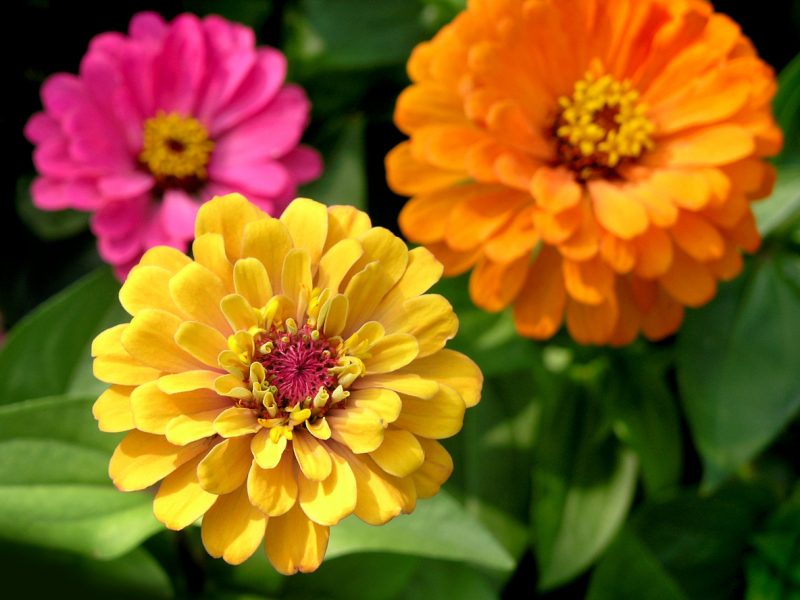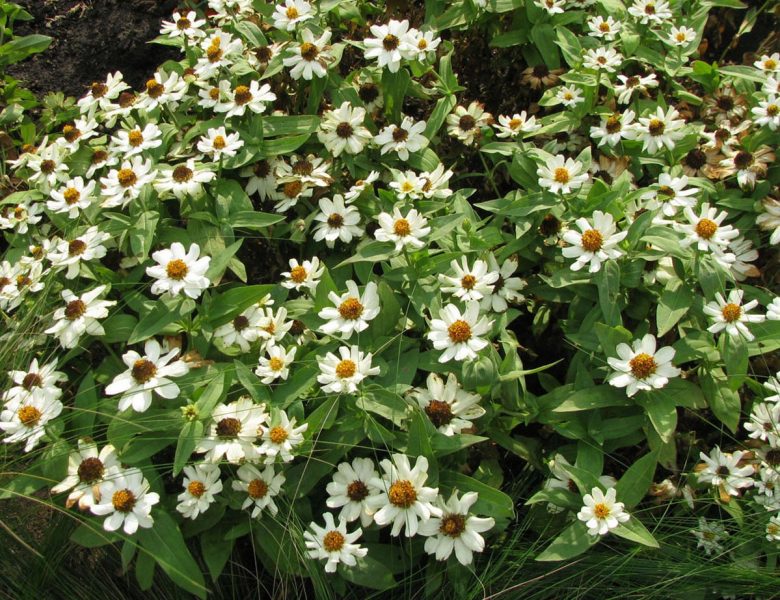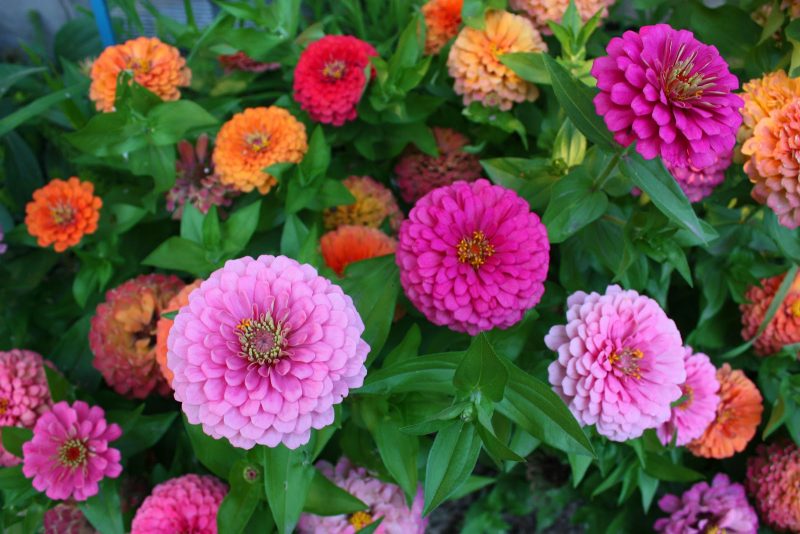In almost every homestead or summer cottage you can admire a flowerbed with flowering majors, they are zinnias, growing and caring for them in the open ground is quite simple. The name of the flower is due to the scientist who brought it from the southern regions of Mexico. Since that historical moment, the majors have become popular: even an inexperienced grower copes with their breeding due to their capricious nature.
Species diversity

In Central America, there are over 20 species, of which four are cultivated: elegant, narrow-leaved, fine-flowered and zinnia linearis. Based on the first two varieties, breeders have bred a large number of varieties and hybrids that are grown in the front gardens.
Zinya graceful
A flower with a direct weakly branched stem exceeding a meter in height. The shoots at the ends are crowned with simple, terry or semi-double inflorescences in the form of baskets, the diameter of which varies from 5 to 16 cm. Flowering begins in June when flowers of all kinds of colors, except for blue, open up and lasts until cold weather.

Among the most popular varieties and hybrids of this variety, classified by the structure and shape of inflorescences, flowering periods or the height of the central shoot, the following stand out:
- "Violet", "Orange kenig", "Polar bear" - varieties included in the class of zinnia dahlia, which stands out powerful bush almost a meter tall. On the shoots of the first order are hemispherical terry inflorescences, the diameter of which is 14 cm;
- "Tom Tumb", "Tambelina", "Little Red Riding Hood" - varieties representing zinnia lilliput, a compact bush which does not exceed half a meter in height and is decorated with terry inflorescences of 5 cm, resembling pompons;
- “Fantasy”, “Gift” - representatives of fantasy zinnia, which has a small bush up to 65 cm high with loose terry inflorescences, consisting of folded into tubes and randomly curved flowers.
Narrow-leaved cynium

An annual culture with an erect, highly branched stalk. Small inflorescences of a saturated orange color are simple, terry. The ground cover classics Classic and Starbright, as well as the Sombrero variety, are classified as distinguished varieties.
Fine-flowered Tsiniya
The variety is ideal for the design of flower gardens and front gardens. Bushes up to 60 cm tall with small inflorescences of 3 cm, consisting of narrowed purple flowers of reed shape. The most popular variety is Red Spider.
Zinia linearis
Due to the thin and pointed leaves, the species is mistaken for narrow-leaved zinnia. This is the smallest variety, spherical bushes of which do not exceed 35 cm in height. Small inflorescences consist of yellow reed flowers with an orange edging. Cultivated in balcony tanks and for decorating alpine slides. Common representatives of the species: similar to the Golden Ay daisy, the beige caramel variety with a black core, as well as YellowStar.
Important! The crossing of elegant and narrow-leaved zinnias allowed the creation of such well-known hybrids as the multi-colored “Profusion”, the highly branched “Magellan” and the bright “Swizzle”.
Growing Zinnia from Seeds
Major breeding is done using seeds, sowing which can be done immediately in open ground or through seedlings.
Sowing seeds in the ground
To obtain friendly seedlings, successful flower growers try to follow the following steps:
- Sowing is carried out after the threat of return frosts disappears - from mid-May to early June.
- A week before the start of sowing, the seeds are wrapped in a warm tissue, saturated with a growth regulator, for germination.
- At this time, a well-lit area is selected, which is cleared of stones and weed vegetation.
- Soil is prepared by applying complex mineral fertilizers and sand, which will create natural drainage.
- After germination, the seed is sown in pre-prepared holes 4 cm deep at a distance of 20 cm from each other so that the majors have room for the development of green mass.
- After a two-week interval, the first sprouts will appear.
Important! The method is acceptable for areas with a warm climate, which provides quick heating of the soil.
Sowing seeds for seedlings
A seedling method suitable for any climatic zone guarantees a successful result when planting seedlings in garden soil after the establishment of stable positive temperatures.
Planting zinnia with this method is carried out according to the following scheme:
- Seeds are also wrapped with a biostimulant-soaked tissue and matured until peeling.
- Fertilized garden soil is placed in a box or individual pots.
- If seeding will be carried out in a box, then the distance between the holes is at least 35 cm to avoid damage to the roots when transplanted to the front garden.
- After sowing, the soil mixture is moistened using a spray gun.
It is interesting: yuka flower care
Outdoor Cinnamon Care
The majors, despite their unpretentiousness, require competent and systematic implementation of care measures, which have their own subtleties.
Watering and loosening
Majors need rare but plentiful hydration. When watering, water must not be allowed to enter the peduncle, which may cause the onset of decay. After moisturizing, the soil will necessarily loosen: the crust has a negative effect on the ability of the plant to form flowers.

Advice! Inflorescences that have completed flowering or have suffered from rain should be removed because of the potential for spotting and rotting.
Top dressing
Additional nutrition to the plant is required when the state is depressed, as evidenced by a lag in development and many yellowed leaf blades. Moira is fed with nitroammophos, superphosphate and potassium sulfate per 1 m2, one tablespoon of each type of fertilizer. Also, in specialized stores a wide range of liquid complex fertilizers is presented, which are applied during watering, stimulating growth, flowering and strengthening the flower's resistance to fungal diseases.

Attention! A working solution of the drug with an acceptable concentration is prepared according to the instructions on the package.
Pest and Disease Control
The flower is susceptible to defeat by fusarium, gray rot, powdery mildew and bacterial spotting, which is expressed by large brownish spots with a burgundy border. If signs of a bacterial disease are detected, damaged shoots are removed, otherwise the intensive development of the disease can lead to death. Against other diseases caused by the fungus, antifungal fungicides are used - Skor, Topaz and other analogues.

Of the pests in the culture, aphids, snails and slugs are noted. The struggle with gastropods is carried out only mechanically. To kill aphids, spraying with tar solution prepared at the rate of 10 g of tar per liter of water is used. If the plant is heavily populated by a parasite, then treatment with Actellik insecticide is organized according to the instructions.
Topping
If the florist wants to get a lush bush, then it is advisable to carry out such a procedure: the central shoot is pinched over a fourth pair of leaves.
Seed collection
Seeds obtained from first-order shoots have the highest sowing qualities.

To organize the proper collection of seed for sowing next year, you should adhere to a number of recommendations:
- Having selected specimens for harvesting seeds, they should cut off all side shoots.
- In selected plants, it is necessary to note the beginning of the dissolution of the buds: after a two-month period of time, as the flowering begins, the seeds ripen.
- After burying the basket, it should be separated, dried and peeled off to obtain seeds.
The cleaned seed is stored in a room with a constant temperature regime for three years without loss of germination.
Perennial Zinnia in winter
The major in open ground is cultivated as an annual crop. But when growing a flower in a container, it is enough with a cooling to transfer it to the room, turning zinnia into a perennial indoor plant.
So, the majors are rightfully considered the main decoration of the flower garden. With a competent approach to planting and care, culture will caress the florist's eyes with a royal look with an abundance of marvelous flowers.












